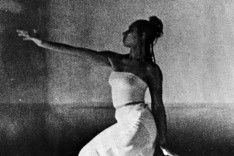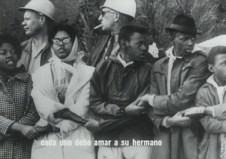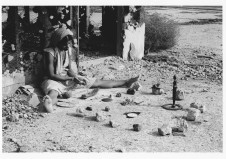Claiming Space: Collage in Cinema

Four Women, by Julie Dash
Los Angeles Filmforum at MOCA
Claiming Space: Collage in Cinema
In Person: Lewis Klahr and Barbara McCullough!
Thursday, January 12, 2017, 7:00 pm
MOCA Grand Avenue, Ahmanson Auditorium, 250 South Grand Avenue, Los Angeles, CA 90012
In an interview with Carrie Mae Weems, Mickalene Thomas says, “It’s so powerful and beautiful to say that sometimes my gaze is a male gaze and also a female gaze. I’m always conflicted.” The central work in Mickalene Thomas: Do I Look Like a Lady? sees Thomas’ recurrent strategies of collage, fragmentation, and multiplicity transferred to the domain of video, where montage provides the means to embody the conflict. In conjunction with the exhibition, Los Angeles Filmforum at MOCA presents a program of experimental films and videos—including the West Coast Premiere of Ephraim Asili’s Kindah as well as films by Santiago Alvarez, Barbara McCullough, Ja’Tovia M. Gary, Jean-Luc Godard, Lewis Klahr, and Betye Saar—that use collage, music, and montage as a way to claim space, create consciousness, or embody a filmic erotics. Klahr and McCullough will be in person to discuss their works.
INFO 213/621-1745 or education@moca.org
TICKETS $12 general admission, $7 students with valid ID
FREE for MOCA & Los Angeles Filmforum members; must present current membership card to claim free tickets.
Tickets available in advance at http://www.brownpapertickets.com/event/258310

Now!, by Santiago Alvarez
Now!
By Santiago Alvarez, 1965, 35mm, black and white, sound, screening from DVD, 5:30
A stark, insistent montage of graphic imagery featuring, as the opening credits announce, “North American blacks and police.” Set to the song “Now!”, sung by Lena Horne, written by Betty Comden, Adolph Green, and Jule Styne, the film’s energy and urgency cannot be overstated. —Madison Brookshire
In the current age of Black Lives Matter and the many disturbing videos of black people being murdered by police, Now! remains socially and culturally relevant. It is easy to make the argument that I was Santiago Alvarez’s intended audience. Although it was made over 50 years ago, it almost felt like I was experiencing my own Facebook news feed in 2016. … How can I watch anymore militarized, destructive, and senseless acts against black people and do nothing? What are these images constructed to do? How is the murder of people who look like me still happening? As Lena sang, “we want more than just a promise”, I feel the need to do something right Now! —Brittany Bellinger
Colored Spade
By Betye Saar, 1971, 16mm, color, sound, screened as digital video, 1:19
Visuals: Betye Saar
Photography: Dennis Welch
Song: James Rado, Gerome Ragni, and Galt Mac Dermot
Galvanized by the assassination of Dr. Martin Luther King Jr. in 1968, Saar had begun to work with the racist images of African American people that have been ubiquitous in American culture. Essentially as an exercise, she assembled some such images to make a film, based on the song “Colored Spade” from the contemporary pop musical Hair. The film is introduced by a black ace of spades on a white ground, which is replaced by Saar's own colored drawing of the same shape; then it becomes a dynamic montage of violently caricatured images from late-nineteenth century and early-twentieth century mass culture—prints, greeting cards, sheet music, comics, food containers, and the like—all roughly synchronized with the song's rhythm and words. Many are animated by camera movement across them (like the still images from popular sources in [Wallace] Berman's film) and by zooms, which play against the extremely rapid cutting. When the song invokes fear of the black bogeyman, however, these images of black people are replaced by images of the Klu Klux Klan and other racist organizations, culminating in a photo of white policemen. Saar zooms in on this image to the point where focus is lost, and when she reverse zooms out, it is to reveal figures from the Civil Rights struggles, Dr. King, Stokely Carmichael, Angela Davis, and the raised fists of Black Power. —David James, The Most Typical Avant-Garde

Four Women, by Julie Dash
Four Women
By Julie Dash, 1975, 16mm, color, sound, 7 minutes
Set to Nina Simone’s stirring ballad of the same name, Julie Dash’s dance film features Linda Martina Young as strong “Aunt Sarah,” tragic mulatto “Saffronia,” sensuous “Sweet Thing” and militant “Peaches.” Kinetic camerawork and editing, richly colored lighting, and meticulous costume, makeup and hair design work together with Young’s sensitive performance to turn longstanding Black female stereotypes to oblique, critical angles. —Jacqueline Stewart

Water Ritual #1: An Urban Rite of Purification, by Barbara McCullough
Water Ritual #1: An Urban Rite of Purification
By Barbara McCullough, 1979, 16mm, black and white, sound, restored to 35mm, screening from DVD, 6 min.
Water Ritual is a beginning point in my quest to create cathartic experiences for myself and my community by the depiction of symbolic actions that communicate with our ancestral, spiritual past. Time and circumstances have served to separate me and my people from the link with that African past and creation of the film was the attempt to forge a link for the sake of our spiritual and psychological survival. The single character in the film, Milanda, embodies both the past and the future. Through ritual, a communion with the Gods takes place. An offering is made. She sets the stage for future change. —Barbara McCullough

Downs are Feminine, by Lewis Klahr
Downs Are Feminine
Lewis Klahr, 1994, 16mm, color, sound, 10 min.
Lewis Klahr's Downs are Feminine unveils a kind of rainy day, indoor, peaceable kingdom of desultory and idyllic debauchery, masturbatory reveries and hermaphroditic transformations. Klahr's oneric collages graft '70s porn of pallid stubbly flesh flagrantly onto Good Housekeeping/Architectural Digest decor (varicolored crab-orchard stone foyers, modacrylic sunbursts, jalousie windows and orientalist metal scrollwork), interior states where characters despoil themselves in Quaalude interludes of dreamy couplings. In this out-of-touch realm, touching is intelligence gathering for a carnal knowledge that will never attain its platonic ideal. The whole atmosphere is pervaded with euphoria, a hopelessness without despair, a contentment beyond longing. —Mark McElhatten
De l'origine du XXIe siècle (Origins of the 21st Century)
By Jean-Luc Godard, 2000, 35mm, black and white and color, sound, screened on DVD, 13 minutes
This film is a piece of political and intellectual agitation: mischievous, powerfully unsettling – and as small, neat and pointed as a bullet. —Peter Bradshaw

An Ecstatic Experience, by Ja’Tovia M. Gary
An Ecstatic Experience
By Ja’Tovia M. Gary, 2015, Digital video, b&w and color, sound, 6 min.
A cinematic invocation and meditation on transcendence as a means of restoration and resistance. —Ja’Tovia M. Gary
Kindah
By Ephraim Asili, 2016, 16mm to digital video, black and white and color, sound, 11.5 minutes
West Coast Premiere!
The fourth film in an ongoing series of 16 mm films exploring my relationship to the African Diaspora. This one was shot in Hudson NY and Accompong, Jamaica. Accompong, Jamaica was founded in 1739 after rebel slaves and their descendants fought a protracted war with the British leading to the establishment of a treaty between the two sides. The treaty signed under British governor Edward Trelawny granted Cudjoe’s Maroons 1500 acres of land between their strongholds of Trelawny Town and Accompong in the Cockpits and a certain amount of political autonomy and economic freedoms. Cudjoe, a leader of the Maroons, is said to have united the Maroons in their fight for autonomy under the Kindah Tree—a large, ancient mango tree that is still standing. —Ephraim Asili
